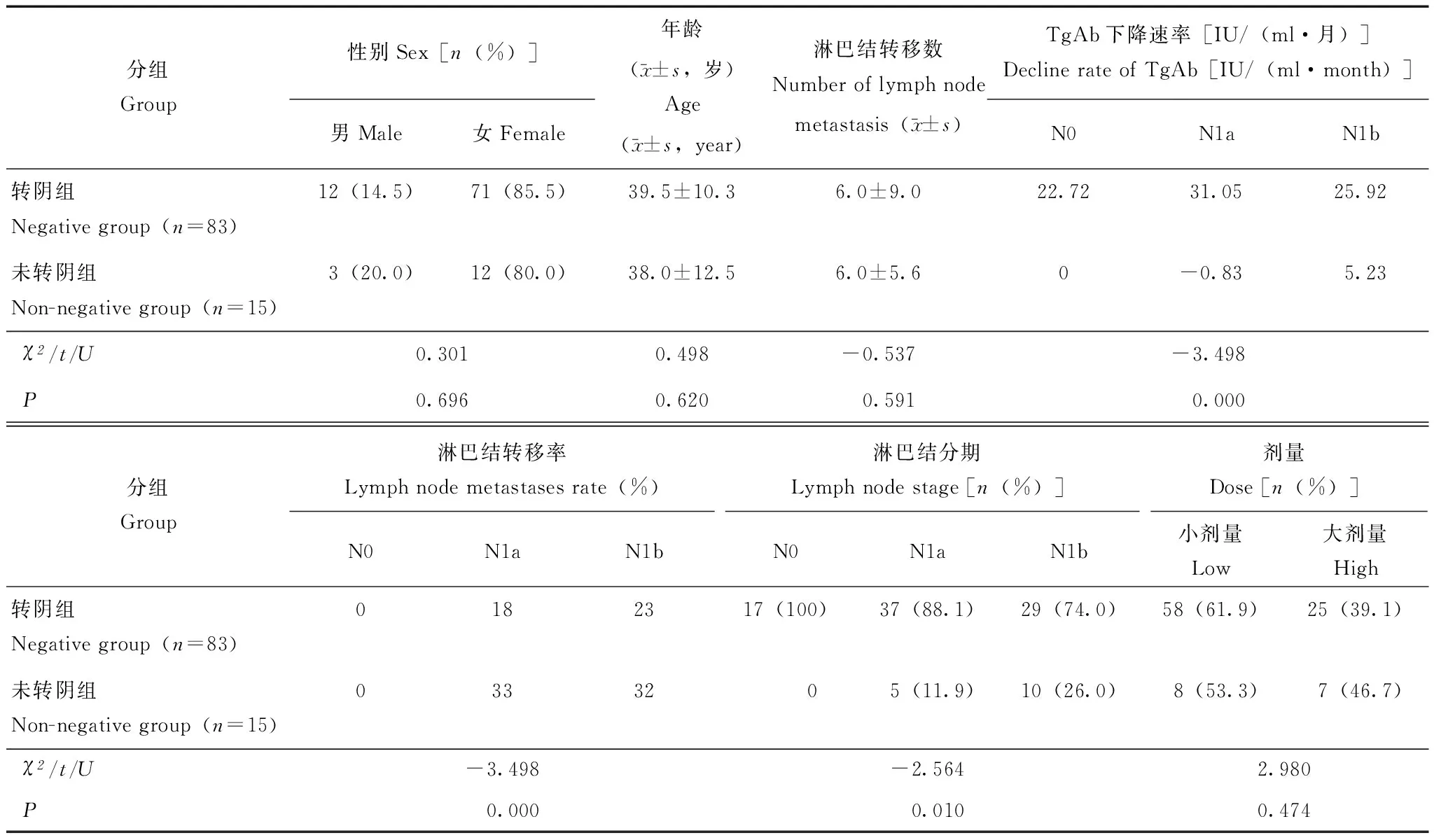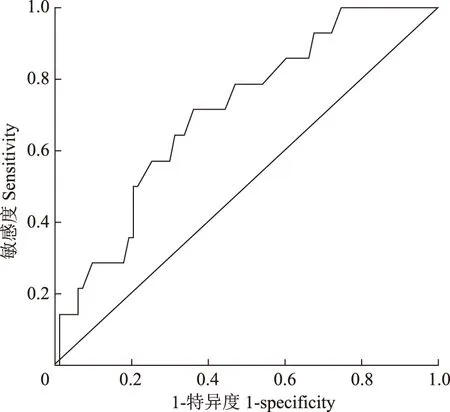淋巴结转移对分化型甲状腺癌手术及131I治疗后血清甲状腺球蛋白抗体转阴的影响
张 腾,宋丽萍,赵 腾,高 文,林岩松
1中国医学科学院 北京协和医学院 北京协和医院核医学科,北京 1007302锦州医科大学 附属第一医院核医学科,辽宁锦州1210013青岛大学 附属医院肿瘤科,山东青岛 266003
淋巴结转移对分化型甲状腺癌手术及131I治疗后血清甲状腺球蛋白抗体转阴的影响
张 腾1,2,宋丽萍2,赵 腾3,高 文3,林岩松1
1中国医学科学院 北京协和医学院 北京协和医院核医学科,北京 1007302锦州医科大学 附属第一医院核医学科,辽宁锦州1210013青岛大学 附属医院肿瘤科,山东青岛 266003
目的 探讨淋巴结转移对分化型甲状腺癌患者经手术及131I治疗后阳性甲状腺球蛋白抗体(TgAb)转阴情况的影响。方法 回顾性分析98例131I治疗前TgAb阳性(≥115 IU/ml)患者,所有患者均行全或近全甲状腺切除+淋巴结清扫术。经过131I“清甲”治疗后中位随访21个月,根据TgAb是否转阴分为转阴组(n=83)和未转阴组(n=15),采用单因素方差分析、χ2检验、Kruskal-Wallis秩和检验比较2组患者的年龄、淋巴结转移数及转移率、淋巴结分期、131I治疗剂量等因素,通过多因素分析探讨影响TgAb转阴的预测因素,并应用受试者工作特征曲线评估影响TgAb转阴因素的预测价值及最佳界值点。结果 未转阴组N1a及N1b比例及淋巴结转移率均显著高于转阴组(Mann-WhitneyU,Z=-3.498,P=0.000),且未转阴组中无N0患者(Fisher’s Exact Test,P=0.032)。受试者工作特征曲线显示,淋巴结转移率预测TgAb转阴界值点为24%,对应的灵敏度为71.4%。多因素分析显示,淋巴结分期可作为预测患者TgAb转阴的独立危险因素(OR=3.183,P=0.038)。结论 淋巴结侵犯及转移率影响TgAb的转阴,淋巴结分期是TgAb转阴的独立预测因素。以24%作为淋巴结转移率的最佳界值点,对预测TgAb转阴具有较高的灵敏度和特异性。
甲状腺癌;甲状腺球蛋白抗体;淋巴结分期;淋巴结转移率;放射性131I消融治疗
甲状腺球蛋白(thyroglobulin,Tg)作为分化型甲状腺癌(differentiated thyroid cancer,DTC)长期随访的重要血清学标记物,对监测肿瘤复发和转移具有较高的灵敏和特异性,但是由于目前检测方法的局限,Tg的检测常受到高滴度(>100 IU/ml)甲状腺球蛋白抗体(thyroglobulin antibody,TgAb)的影响[1],这主要取决于TgAb表面识别体的数量[2],而且还与抗体亲和力、特异性、血清用量和TgAb特性相关[3],进而影响对患者临床转归的判断。因此,检测TgAb随时间变化将有助于监测肿瘤的复发提供重要信息,Hjiyiannakis等[4]报道TgAb随时间而降低往往提示治疗有效;相反,TgAb随时间而增加可早期提示肿瘤复发。影响TgAb转阴的影响因素的报道较少,本课题组的前期研究显示,硒酵母片、手术前TgAb的水平以及手术后到131I治疗的时间对TgAb的转阴产生影响[5- 7],其中,肿瘤的侵袭性可以影响患者临床转归[8- 10]。而淋巴结作为DTC侵袭性的特征之一,鲜有其与TgAb转阴之间关系的报道。本研究旨在探讨淋巴结与TgAb转阴之间的关系。
资料和方法
一般资料 回顾性分析2012至2015年于北京协和医院行术后131I治疗的98例TgAb阳性(≥115 U/ml)患者的临床资料。纳入标准:(1)术前及131I治疗前TgAb阳性(≥115 U/ml);(2)术后病理证实为甲状腺乳头状癌;(3)手术及131I“清甲”治疗时无远处转移的证据,其中男性15例、女性83例,平均年龄(39.3±10.5)岁;(4)手术方式为全或近全甲状腺切除,术后行131I治疗及促甲状腺激素抑制治疗,其中有67例是病理诊断合并桥本氏甲状腺炎,男性7例、女性60例,平均年龄(38.7±11.4)岁。
131I“清甲”治疗131I治疗准备和方案制定均参照美国甲状腺协会指南及2015年中国131I治疗分化型甲状腺癌指南[11],131I治疗前常规检测术后未服或停服甲状腺激素致促甲状腺激素升高状态(>30 mU/L)下的血清刺激性甲状腺球蛋白及相应TgAb水平。131I治疗剂量为1.1~5.5 GBq,治疗后规律随访。
方法 Tg和TgAb的测定采用电化学发光免疫分析法(罗氏,E170),检测范围分别为0.04~500 ng/ml和10~4000 IU/ml。TgAb正常范围上显示115 IU/ml,Tg、TgAb若超过正常范围上限分别记为500 ng/ml和4000 U/ml。以TgAb<115 IU/ml为转阴值,比较转阴组、未转阴组及全部患者中131I治疗后TgAb半年的下降速率、淋巴结转移率以及淋巴结分期间的关系。淋巴结转移率计算公式:淋巴结转移数/淋巴结清扫数;TgAb半年下降速率计算公式为:(TgAb碘治疗前-TgAb治疗后半年)/复查月数。
统计学处理 应用SPSS 22.0软件进行数据分析。采用单因素方差分析、χ2检验、Mann-WhitneyU秩和检验比较2组患者的基本临床特征、TgAb下降速率、淋巴结转移率及淋巴结分期、治疗后反应分组、淋巴结清扫数量、碘治疗前TgAb水平、半年速率分组、一年速率分组、半年速率、一年速率等。应用受试者工作特征曲线评估淋巴结转移率预测TgAb转阴的价值及最佳界值点,并进一步通过多因素分析评估TgAb转阴的独立预测因素。P<0.05为差异有统计学意义。
结 果
一般情况 98例TgAb阳性的DTC患者平均年龄(39.3±10.5)岁,其中男性15例,其平均年龄(37.8±11.9)岁;女性83例,其平均年龄(39.5±10.4)岁。转阴组83例、未转阴组15例。转阴组与未转阴组患者年龄(P=0.620)、性别比(P=0.696)差异无统计学意义(表1)。
TgAb转阴情况与淋巴结分期的关系 经过21.0个月的中位随访时间,即N0的患者全部达到TgAb转阴,而N1a、N1b的患者中未转阴者显著增多(Mann-WhitneyU=-2.564,P=0.010)(表1)。
TgAb转阴情况与淋巴结转移率的关系 转阴组中位淋巴结转移率显著低于未转阴组(Mann-WhitneyU=-3.498,P=0.000)。其中转阴组转移率中位数为14%;未转阴组淋巴结转移率中位数为33%,均明显高于转阴组(P=0.000)(表1)。受试者工作特征曲线显示,区分TgAb转阴与否的淋巴结转移率的界值点为24%(灵敏度为71.4%、特异性为36.1%)(图1)。
各淋巴结分期TgAb下降速率与TgAb转阴的关系 转阴组中,N1a、N1b的TgAb下降速率显著高于未转阴组(表1),且N0的患者TgAb全部转阴(Mann-WhitneyU=-3.498,P=0.000)(表1)。转阴组和未转阴组TgAb中位下降速率分别为27.31、4.43 IU/(ml·月),其中转阴组中N1a、N1b患者TgAb中位下降速率明显高于未转阴组(P=0.000)(表1)。

表 1 98例分化型甲状腺癌的临床特征Table 1 Clinical characteristics of 98 differentiated thyroid carcinoma patients
TgAb:甲状腺球蛋白抗体
TgAb:thyroglobulin antibody

图 1 预测阳性TgAb转阴淋巴结转移率的受试者工作特征曲线
Fig 1 The receiver operating characteristic curve of lymph node metastases rate in predicting the disappearance of positive TgAb
TgAb是否转阴与淋巴结转移率、淋巴结分期及TgAb下降速率的关系 淋巴结分期(OR=3.183,P=0.038)可作为影响患者TgAb转阴的独立危险因素,而淋巴结转移率(OR=5.271,P=0.234)、TgAb下降速率(OR=0.980,P=0.077)不能作为衡量TgAb是否转移的独立危险因素(表2)。
讨 论
TgAb是针对Tg产生的抑制性自身抗体,主要来源于甲状腺内淋巴细胞,有研究显示,DTC有高达25%的患者会出现TgAb阳性[3],由于高滴度TgAb可降低Tg作为DTC肿瘤标记物的敏感性,从而影响TgAb阳性患者的随访。此时,TgAb的变化将对治疗具有一定的预示作用;Hjiyiannakis等[4]研究显示,TgAb随时间而降低往往提示治疗有效;而TgAb随时间而增加可早期提示肿瘤复发。美国甲状腺协会指南亦提出,在高滴度TgAb时,TgAb可用于监测病情的变化[11]。因阳性TgAb的变化及其转阴影响阳性TgAb患者的治疗决策及随诊策略,所以,探索TgAb的转阴影响因素对患者后期的随访至关重要。本课题组针对TgAb转阴因素的前期系列研究显示,DTC患者131I治疗后TgAb的中位转阴时间与131I治疗前TgAb水平有关,患者在经131I治疗后中位转阴时间为10.0个月[5];手术、13lI治疗干预有助于TgAb的降低,131I治疗距手术时间是TgAb下降的重要影响因素[6],硒制剂亦能有效降低TgAb阳性DTC患者的TgAb水平[7]。另有研究显示,中央区淋巴结转移的数目大于3个时,与DTC患者的预后相关[12],并且Vasileiadis等[13]也指出,阳性TgAb与转移淋巴结呈正相关。
本研究显示淋巴结分期影响着TgAb的转阴,淋巴结受累较重的N1b患者TgAb转阴率不足80%,而无淋巴结转移患者经手术及131I治疗后中位21个月的随访时间内其TgAb迅速转阴。淋巴结受累较轻的N1a患者的转阴率亦高于N1b组。经多因素分析显示,淋巴结分期可作为影响患者TgAb转阴的独立危险因素(OR=3.183,P=0.038),且淋巴结分期与TgAb转阴呈负相关。TgAb转阴组患者的中位淋巴结转移率显著低于未转阴组(P=0.000),提示淋巴结转移率亦是影响TgAb转阴的重要因素。通过受试者工作特征曲线分析得到淋巴结转移率预测TgAb转阴的最佳界值点为24%,其敏感性为71.4%,提示在131I治疗决策及随诊时应密切关注淋巴结转移率较高的TgAb阳性患者,增加131I治疗剂量是否会改善这部分患者的预后尚待进一步研究。淋巴结受累主要通过影响TgAb下降速率影响其转阴,淋巴结侵袭性较高的N1b患者TgAb下降速率明显减慢。
由于本研究为单中心回顾性研究,仍存在样本例数等方面的局限性。此外,因本研究纳入的淋巴结转移率这一指标与手术清扫淋巴结数目有关,不同手术术式也对本研究产生一定的影响。

表 2 两组患者淋巴结转移率、淋巴结分期及甲状腺球蛋白抗体下降速率的Cox回归分析结果Table 2 Cox regression analysis of lymph node metastasis rate,lymph node stage,and decline rate of TgAb in two groups
B:偏回归系数;SE:标准误;Wald:卡方值;df:自由度
B:partial regression coefficient;SE:standard error;Wald:Chi-square values;df:degree of freedom
综上,淋巴结分期和淋巴结转移率均是影响TgAb转阴的重要因素,以淋巴结转移率为24%这一界值点有助于早期识别TgAb持续阳性的患者,为这部分患者的131I治疗决策提供辅助权重依据。
[1]Rahmoun MN,Bendahmane I.Anti-thyroglobulin antibodies in differentiated thyroid carcinoma patients:study of the clinical and biological parameters[J].Ann Endocrinol(Paris),2014,75(1):15- 18.
[2]Okosieme OE,Evans C,Moss L,et al.Thyroglobulin antibodies in serum of patients with differentiated thyroid cancer:relationship between epitope specificities and thyroglobulin recovery [J].Clin Chem,2005,51(4):729- 734.
[3]Spencer CA,Takeuchi M,Kazarosyan M,et al.Serum thyroglobulin autoantibodies:prevalence,influence on serum thyroglobulin measurement,and prognostice significance in patients with differentiated thyroid carcinoma[J].J Clin Endocrinol Metab,1998,83(4):1121- 1127.
[4]Hjiyiannakis P,Mundy J,Harmer C.Thyroglobulin antibodies indifferentiated thyroid cancer[J].Clin Oncol(R CollRadiol),1999,11(4):240- 244.
[5]李田军,林岩松,梁军,等.甲状腺球蛋白抗体在甲状腺乳头状癌131I治疗后的转阴时间及其影响因素[J].中国医学科学院学报,2012,34(3):258- 261.
[6]丛慧,梁军,李方,等.分化型甲状腺癌治疗后TgAb变化趋势及其影响因素[J].中国医学科学院学报,2015,37(1):61- 65.
[7]丛慧,李慧,梁军,等.硒制剂对甲状腺球蛋白抗体阳性分化型甲状腺癌甲状腺抗体水平的影响[J].中国医学科学院学报,2015,37(5):591- 595.
[8]Ito Y,Higashiyama T,Takamura Y,et al.Risk factors for recurrence to the lymph node in papillary thyroid carcinoma patients without preoperatively detectable lateral node metastasis:validity of prophylactic modified radical neck dissection[J].World J Surg,2007,31(11):2085- 2091.
[9]Mercante G,Frasoldati A,Pedroni C,et al.Prognostic factors affecting neck lymph node recurrence and distant metastasis in papillary microcarcinoma of the thyroid:results of a study in 445 patients[J].Thyroid,2009,19(7):707- 716.
[10]Moreno-Egea A,Rodriguez-Gonzalez JM,Sola-Perez J,et al.Multivariate analysis of histopathological features as prognostic factors in patients with papillary thyroid carcinoma[J].Br J Surg,1995,82(8):1092- 1094.
[11]Haugen BR,Alexander EK,Bible KC,et al.2015 American Thyroid Association(ATA)management guidelines foradult patients with thyroid nodules and differentiated thyroid cancer[J].Thyroid,2016,26(1):1- 133.
[12]Lee YS,Lim YS,Lee JC,et al.Clinical implication of the number of central lymph node metastasis in papillary thyroid carcinoma:preliminary report [J].Word J Surg,2010,34(11):2558- 2563.
[13]Vasileiadis I,Boutzios G,Charitoudis G,et al.Thyroglobulin antibodies could be a potential predictive marker for papillary thyroid carcinoma[J].Ann Surg Oncol,2014,21(8):2725- 2732.
Effect of Lymph Node Metastasis on Change of Positive Thyroglobulin Antibody in Differentiated Thyroid Carcinoma after Initial Treatment
ZHANG Teng1,2,SONG Liping2,ZHAO Teng3,GAO Wen3,LIN Yansong1
1Department of Nuclear Medicine,PUMC Hospital,CAMS and PUMC,Beijing 100730,China2Department of Imaging and Nuclear Medicine,the First Affiliated Hospital of Jinzhou Medical University,Jinzhou,Liaoning 121001,China3Department of Oncology,the Affiliated Hospital of Qingdao University,Qingdao,Shandong 266003,China
LIN Yansong Tel:010- 69155610,E-mail:linys@pumch.cn
Objective To investigate the influence of lymph node metastasis on the change of positive thyroglobulin antibody(TgAb)in differentiated thyroid carcinoma after initial treatment.Methods We retrospectively analyzed the clinical data of 98 differentiated thyroid carcinoma patients with positive TgAb(≥115 IU/ml)before radioiodine(RAI)therapy.All of whom underwent total or near total thyroidectomy,neck lymph node dissection,and subsequent RAI therapy.Patients were divided into negative group(n=83)and non-negative group(n=15)according to the disappearance of positive TgAb or not after a mean follow-up of 21.0 months.Analysis of variance,χ2test,and Mann-Whitney rank-sum test were applied to compare the basic clinical features including number of metastatic lymph nodes,lymph node metastasis rate and node stage,and dose of RAI ablation.The receiver operating characteristic curves were employed to evaluate the predictive values of TgAb levels(negative or positive)and optimal cut-off points.Multivariate analyses were further performed to explore the independent indicators for persistent positive TgAb.Results Compared with the negative group,the proportions of N1a and N1b in the non-negative group were significantly higher,with no N0 in the non-negative group(Fisher’s Exact Test,P=0.032).The median metastatic lymph node rate was also significantly higher in the non-negative group(Mann-WhitneyU=-3.498,P=0.000).The cut-off value for metastatic lymph node rate to predicting disappearance of positive TgAb was 24%,and its sensitivity was 71.4%.The multivariate analysis showed that only lymph node stage(OR=3.183,P=0.038)was the independent indicator for persistent positive TgAb.Conclusions Lymph node stage was an independent indicator for the disappearance of positive TgAb.A metastatic lymph node rate of higher than 24% may be predictive for the disappearance of positive TgAb.
thyroid carcinoma;thyroglobulin antibody;lymph node stage;lymph node metastatic rate;radioiodine remnant ablation
539-543
国家自然科学基金(81571714)和卫生部行业科研专项项目(201202012)Supported by the National Natural Sciences Foundation of China(81571714)and the Minister of Health Industry Special Scientific Research Project(201202012)
林岩松 电话:010- 69155610,电子邮件:linys@pumch.cn
R736.1
A
1000- 503X(2017)04- 0539- 05
10.3881/j.issn.1000- 503X.2017.04.013
2016- 07- 06)
第一、二位作者对本文贡献相同The first two authors contributed qually to this article

